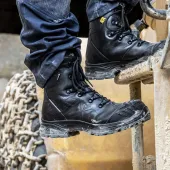Welding fume reclassified as carcinogenic

Health and Safety Executive announces change in enforcement expectations for mild steel welding fume
WELDING remains one of the most common activities carried out in industry, but exposure to welding fume and other gases associated with welding can cause a range of ill-health conditions.
The International Agency for Research on Cancer (IARC) has recently reviewed the scientific evidence and concluded that exposure to mild steel welding fume can cause lung cancer and possibly kidney cancer in humans.
These conclusions have been endorsed by the Workplace Health Expert Committee, an independent body that provides expert scientific and medical opinion on matters relating to workplace health.
The reclassification of welding fume as a human carcinogen means that all businesses carrying out welding are required to ensure effective engineering controls are provided and correctly used to control fume. General ventilation alone does not achieve the necessary level of control.
Suitable engineering control for all welding activities indoors includes the use of local exhaust ventilation (LEV), to reduce exposures to airborne contaminants such as dust, mist, fume, vapour or gas in a workplace.
Where LEV alone does not adequately control exposure, it should be supplemented by adequate and suitable respiratory protective equipment (RPE) to protect against the residual fume. Appropriate RPE should also be provided for welding outdoors.
Regardless of duration, the Health and Safety Executive (HSE) says it is no longer acceptable for welding to be undertaken without any suitable exposure-control measures in place, as there is no known level of safe exposure.
In summary, employers should ensure the following measures are put in place for any welding activities.
- Make sure exposure to any welding fume released is adequately controlled using engineering controls (typically LEV).
- Make sure suitable controls are provided for all welding activities, irrelevant of duration. This includes welding outdoors.
- Where engineering controls alone cannot control exposure, adequate and suitable RPE should be provided to control risk from any residual fume.
- Make sure all engineering controls such as LEV are correctly used, suitably maintained and subject to thorough examination and test where required. Further information in relation to LEV can be found in HSG258, Controlling airborne contaminants at work: A guide to local exhaust ventilation (LEV).
- Ensure the correct selection and use of any RPE. Further information in relation to the selection and use of RPE can be found within HSG53, Respiratory protective equipment at work, a practical guide.
The HSE adds that risk assessments should reflect the change in the expected control measures.









